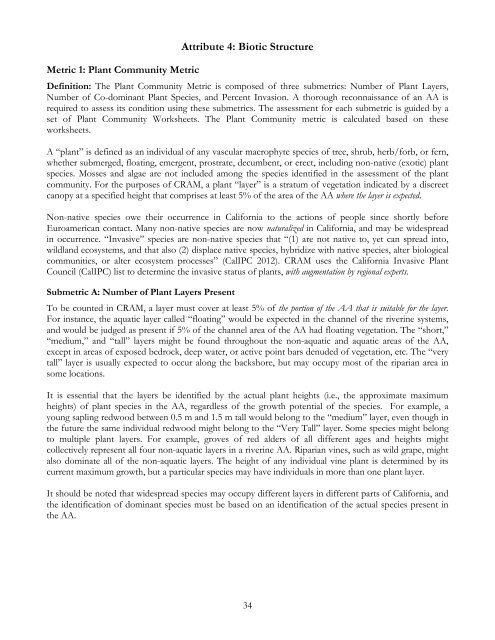You also want an ePaper? Increase the reach of your titles
YUMPU automatically turns print PDFs into web optimized ePapers that Google loves.
Metric 1: Plant Community Metric<br />
Attribute 4: Biotic Structure<br />
Definition: The Plant Community Metric is composed of three submetrics: Number of Plant Layers,<br />
Number of Co-dominant Plant Species, and Percent Invasion. A thorough reconnaissance of an AA is<br />
required to assess its condition using these submetrics. The assessment for each submetric is guided by a<br />
set of Plant Community Worksheets. The Plant Community metric is calculated based on these<br />
worksheets.<br />
A “plant” is defined as an individual of any vascular macrophyte species of tree, shrub, herb/forb, or fern,<br />
whether submerged, floating, emergent, prostrate, decumbent, or erect, including non-native (exotic) plant<br />
species. Mosses and algae are not included among the species identified in the assessment of the plant<br />
community. For the purposes of CRAM, a plant “layer” is a stratum of vegetation indicated by a discreet<br />
canopy at a specified height that comprises at least 5% of the area of the AA where the layer is expected.<br />
Non-native species owe their occurrence in California to the actions of people since shortly before<br />
Euroamerican contact. Many non-native species are now naturalized in California, and may be widespread<br />
in occurrence. “Invasive” species are non-native species that “(1) are not native to, yet can spread into,<br />
wildland ecosystems, and that also (2) displace native species, hybridize with native species, alter biological<br />
communities, or alter ecosystem processes” (CalIPC 2012). CRAM uses the California Invasive Plant<br />
Council (CalIPC) list to determine the invasive status of plants, with augmentation by regional experts.<br />
Submetric A: Number of Plant Layers Present<br />
To be counted in CRAM, a layer must cover at least 5% of the portion of the AA that is suitable for the layer.<br />
For instance, the aquatic layer called “floating” would be expected in the channel of the riverine systems,<br />
and would be judged as present if 5% of the channel area of the AA had floating vegetation. The “short,”<br />
“medium,” and “tall” layers might be found throughout the non-aquatic and aquatic areas of the AA,<br />
except in areas of exposed bedrock, deep water, or active point bars denuded of vegetation, etc. The “very<br />
tall” layer is usually expected to occur along the backshore, but may occupy most of the riparian area in<br />
some locations.<br />
It is essential that the layers be identified by the actual plant heights (i.e., the approximate maximum<br />
heights) of plant species in the AA, regardless of the growth potential of the species. For example, a<br />
young sapling redwood between 0.5 m and 1.5 m tall would belong to the “medium” layer, even though in<br />
the future the same individual redwood might belong to the “Very Tall” layer. Some species might belong<br />
to multiple plant layers. For example, groves of red alders of all different ages and heights might<br />
collectively represent all four non-aquatic layers in a riverine AA. Riparian vines, such as wild grape, might<br />
also dominate all of the non-aquatic layers. The height of any individual vine plant is determined by its<br />
current maximum growth, but a particular species may have individuals in more than one plant layer.<br />
It should be noted that widespread species may occupy different layers in different parts of California, and<br />
the identification of dominant species must be based on an identification of the actual species present in<br />
the AA.<br />
34















